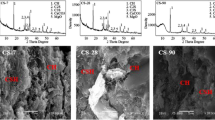Abstract
Silica fume (SF) has been used since long as a mineral admixture to improve durability and produce high strength and high performance concrete. Due to the pozzolanic reaction between calcium hydroxide and silica fume, compared with ordinary Portland cement, the carbonation of concrete containing silica fume is much more complex. In this paper, based on a multi-component concept, a numerical model is built which can predict the carbonation of concrete containing silica fume. The proposed model starts with the mix proportions of concrete and considers both Portland cement hydration reaction and pozzolanic reaction. The amount of hydration products which are susceptible to carbonate, such as calcium hydroxide (CH) and calcium silicate hydrate (CSH), as well as porosity can be obtained as associated results of the proposed model during the hydration period. The influence of water-binder ratio and silica fume content on carbonation is considered. The predicted results agree well with experimental results.









Similar content being viewed by others
References
Kumar Metha P (2006) Concrete-microstructure, properties and materials. MacGraw-Hill, New York
Matala S (1997) Carbonation mechanism in the granulate blast furnace slag concrete. In: Chandra S (ed) Proceedings of tenth international congress chemistry of cement. Gothenburg, 1997
Papadakis VG, Vayenas CG, Fardis MN (1991) Fundamental modeling and experimental investigation of concrete carbonation. ACI Mater J 88:363–373
Nagataki S, Ohga H, Kim EK (1986)Effects of curing conditions on the carbonation of concrete with fly ash and the corrosion of reinforcement in long-term tests. In: Proceedings of second international conference on the use of fly ash, silica fume, slag and natural pozzolans in concrete, SP 91, Madrid, 1986
Nagataki S, Mansur MA, Ohga H (1988) Carbonation of mortar in relation to ferrocement construction. ACI Mater J 85:17–25
Tuutti K (1982) Corrosion of steel in concrete. Swedish Cement and Concrete Research Institute, Stockholm
Papadakis VG, Vayenas CG, Fardis MN (1991) Physical and chemical characteristics affecting the durability of concrete. ACI Mater J 88:186–196
Papadakis VG, Vayenas CG, Fardis MN (1991) Experimental investigation and mathematical modeling of the concrete carbonation problem. Chem Eng Sci 46:1333–1338. doi:10.1016/0009-2509(91)85060-B
Jiang LX, Zhang Y, Liu YQ, Zhang X, Xie HF, Wang J (1996) Experiment study and calculation formula of carbonation depth. Chin J Concr 4:12–16
Jiang L, Lin B, Cai Y (2000) A model for predicting carbonation of high volume concrete, cement and concrete research. Cement Concr Res 30:699–702. doi:10.1016/S0008-8846(00)00227-1
Papadakis VG (1999) Experimental investigation and theoretical modeling of silica fume activity in concrete. Cement Concr Res 29:79–86. doi:10.1016/S0008-8846(98)00171-9
Papadakis VG, Tsimas S (2000) Effect of supplementary cementing materials on concrete resistance against carbonation and chloride ingress. Cement Concr Res 30:291–299. doi:10.1016/S0008-8846(99)00249-5
Papadakis VG (1999) Effect of fly ash on Portland cement systems, Part I: low-calcium fly ash. Cement Concr Res 29:1727–1736. doi:10.1016/S0008-8846(99)00153-2
Papadakis VG (2000) Effect of fly ash on Portland cement systems, Part II: high calcium fly ash. Cement Concr Res 30:1647–1654. doi:10.1016/S0008-8846(00)00388-4
Papadakis VG, Vayenas CG, Fardis MN (1992) Hydration and carbonation of pozzolanic cements. ACI Mater J 89:119–130
Rosin P, Rammler E (1933) Regularities in the distribution of cement particles. J Inst Fuel 7:29–33
Navi P, Pignat C (1996) Simulation of cement hydration and the connectivity of the capillary pore space. Adv Cement Base Mater 4:58–67
Park K-B, Noguchib T, Plawsky J (2005) Modeling of hydration reaction using neural network to predict the average properties of cement paste. Cement Concr Res 35:1676–1684. doi:10.1016/j.cemconres.2004.08.004
Tomosawa F (1997) Development of a kinetic model for hydration of cement. In: Chandra S (ed) Proceedings of tenth international congress chemistry of cement. Gothenburg, 1997
Brouwers HJH (2004) The work of powers and Brownyard revisited: part 1. Cement Concr Res 34:1697–1716. doi:10.1016/j.cemconres.2004.05.031
Maruyama I (2003) Numerical model for hydration of Portland cement. In: Proceedings of the international conference of civil and environmental engineering, Hiroshima, 2003
Takemoto K, Uchikawa H (1980) Hydration of pozzolanic cement. In: Proceedings of the 7th international congress on chemistry of cement, Paris, 1980
Saeki T, Monteiro PJM (2005) A model to predict the amount of calcium hydroxide in concrete containing mineral admixture. Cement Concr Res 35:1914–1921. doi:10.1016/j.cemconres.2004.11.018
Pane I, Hansen W (2005) Investigation of blended cement hydration by isothermal calorimetry and thermal analysis. Cement Concr Res 35:1155–1164. doi:10.1016/j.cemconres.2004.10.027
Maruyama I, Masahiro S, Ryoichi S (2005) Prediction of temperature in ultra high-strength concrete based on temperature dependent hydration model. In: Proceedings of 7th international symposium on high performance concrete, 2005
Jensen OM, Hansen PF (2001) Water-entrained cement-based materials, I: principles and theoretical background. Cement Concr Res 31:647–654. doi:10.1016/S0008-8846(01)00463-X
Matsushita T, Hoshino S, Maruyama I, Noguchi T, Yamada K (2007) Effect of curing temperature and water to cement ratio on hydration of cement compounds. In: Beaudoin J (ed) Proceedings of 12th international congress chemistry of cement, Montreal, 2007
Goldman A, Bentur A (1989) Bond effects in high-strength silica fume concretes. ACI Mater J 86:440–449
Houst YF (1996) The role of moisture in the carbonation of cementitious materials, Internationale Zeitschrift für Bauinstandsetzen 2. Jahrgang 1:49–66
Parrot LJ (1991) Carbonation, moisture and empty pores. Adv Cement Res 4:111–118
Sulapha P, Wong SF, Wee TH, Swaddiwudhipong S (2003) Carbonation of concrete containing mineral admixtures. J Mater Civ Eng 15:134–143. doi:10.1061/(ASCE)0899-1561(2003)15:2(134)
Acknowledgement
The authors are grateful to the reviewers for their valuable comments.
Author information
Authors and Affiliations
Corresponding author
Rights and permissions
About this article
Cite this article
Wang, XY., Lee, HS. A model predicting carbonation depth of concrete containing silica fume. Mater Struct 42, 691–704 (2009). https://doi.org/10.1617/s11527-008-9413-7
Received:
Accepted:
Published:
Issue Date:
DOI: https://doi.org/10.1617/s11527-008-9413-7




